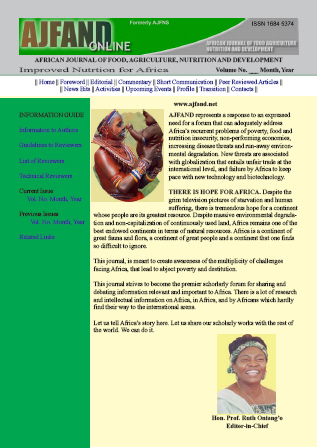
|
African Journal of Food, Agriculture, Nutrition and Development
Rural Outreach Program
ISSN: 1684-5358
EISSN: 1684-5358
Vol. 3, No. 1, 2003
|
 Bioline Code: nd03005
Bioline Code: nd03005
Full paper language: English
Document type: Research Article
Document available free of charge
|
|
|
African Journal of Food, Agriculture, Nutrition and Development, Vol. 3, No. 1, 2003
| fr |
METHODS DE PRODUCTION ET COMPOSITION DE BUSHERA: UNE BOISSON DE CEREALES FERMENTEES TRADITIONELLE EN OUGANDA
Muyanja CMBK, Kikafunda JK, Narvhus JA, Helgetun K and T Langsrud
Résumé
Une étude basée sur les réponses à un questionnaire a été menée pour documenter les méthodes de production du Bushera, une boisson de céréales fermentées traditionnelle en Ouganda, dans les districts de Kabale et Rukungiri situés dans la région sud-ouest de l'Ouganda. La composition chimique des matières premières et du Bushera a été établie par méthodes standard. On a observé des similarités dans la production du Bushera dans les districts de Kabale et de Rukungiri. Dans les deux districts, les graines de sorgho sont habituellement (80% des réponses) trempées dans de l'eau pendant une nuit (12h), certains ménages (20%) signalant une période de trempage de 24-48h.Les graines sont trempées dans des ruisseaux, rivières et étangs par 87% des ménages. La période de germination des graines de sorgho varie de 2 à 4 jours. Soixante-cinq pour cent des ménages font germer les graines pendant 2-3 jours. La durée de fermentation du Bushera va de 1 à 6 jours. La majorité des ménages (90%) consomment le Bushera après 2-4 jours de fermentation.
Le contenu des graines de sorgho germées et non germées en humidité, graisses, protéines et féculents était de 8,8-12,4%; 1,8-3.0%; 7,7-10,8%; et 77,7-80,2% respectivement. La farine de sorgho germé a une moindre teneur en graisses, protéines et féculents mais une plus forte teneur en cendres et fibres que la farine de sorgho non germé. La farine de millet germé contient plus d'humidité, protéines et fibres que la farine non germée, tandis que cette dernière a une plus forte teneur en cendres et féculents. La germination entraîne une augmentation de la concentration des sucres dans les graines de sorgho et de millet. On a constaté d'importantes variations dans la composition approximative du Bushera obtenu auprès des ménages. En laboratoire, le contenu en protéines du Bushera fait de graines germées était plus élevé que dans le Bushera de graines non germées (12,2% comparé à 10,6%), sur base de matières sèches. Des niveaux plus élevés de fer, magnésium et zinc ont été observés dans les graines germées en raison de l'apport de cendres de bois pendant la germination. Les graines germées avaient une plus basse teneur en phénol et en tanin comparé aux graines non germées.
Germination, Fermentation, Sorgho, Millet, Bushera
|
| |
| en |
PRODUCTION METHODS AND COMPOSITION OF BUSHERA: A Ugandan Traditional Fermented Cereal Beverage
Muyanja CMBK, Kikafunda JK, Narvhus JA, Helgetun K and T Langsrud
Abstract
A survey was conducted using a questionnaire to document the production methods of Bushera, a Ugandan traditional fermented cereal beverage, in the districts of Kabale and Rukungiri in the South Western region of Uganda. The chemical composition of raw materials and Bushera was determined using standard methods. Similarities in the production of Bushera in Kabale and Rukungiri districts were observed. In both districts, sorghum grains are usually (80% of respondents) soaked in water overnight (12 h), some households (20%) indicated a soaking period of 24-48 h. Eighty seven percent of the households soaked the grains in streams, rivers and ponds. The germination period for sorghum grains varied between two and four days. Sixty five percent of the households germinated the grains for two-three days. The duration of fermentation of Bushera ranged from one to six days. Most of the households (90%) consumed Bushera after two-four days of fermentation. The moisture, fat, protein and carbohydrate contents of germinated and non-germinated sorghum grains ranged from 8.8-12.4 %, 1.8-3.0 %, 7.2-10.8 % and 77.7-85.7%, respectively. Germinated sorghum flour had lower fat, protein and carbohydrate contents but higher ash and fibre than non-germinated sorghum flour. Germinated millet flour had higher moisture, protein and fibre compared to the non-germinated flour while the latter had higher ash and carbohydrate contents. Germination resulted in an increase in the concentration of sugars in both sorghum and millet grains. Great variations were observed in the proximate composition of Bushera obtained from the households. Under laboratory conditions, the protein content of Bushera produced from germinated grains was higher than Bushera from non-germinated grains (12.2% vs. 10.6%), on dry matter basis. Higher levels of iron, magnesium and zinc were observed in germinated grains due to addition of wood ash during germination. Germinated grains had lower phenol and tannin content compared to non-germinated grains.
Keywords
Germination, Fermentation, Sorghum, Millets, Bushera
|
| |
© Copyright 2003 -Rural Outreach Program
Alternative site location: http://www.ajfand.net/
|
|
